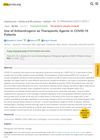Search
for
Sort by
Research
450-480 / 1000+ results
research New and Consolidated Therapeutic Options for Pubertal Induction in Hypogonadism: In-Depth Review of the Literature
There are various effective hormone treatments for puberty induction in boys and girls with hypogonadism, and starting treatment early is important.

research Translational Research in the Generation of Therapeutic Medicine for Wound Healing: A Review
New therapies show promise for wound healing, but more research is needed for safe, affordable options.
research Alopecia Areata: What’s New in Epidemiology, Pathogenesis, Diagnosis, and Therapeutic Options?
New insights into the causes and treatments for the autoimmune hair loss condition Alopecia areata have been made.

research The Changing Landscape of Alopecia Areata: The Therapeutic Paradigm
New treatments for Alopecia Areata, like JAK inhibitors, show promise for hair regrowth and are likely to change future treatment approaches.

research Female Pattern Hair Loss: A Clinical, Pathophysiologic, and Therapeutic Review
No cure for female pattern hair loss, but various effective treatments exist.

research Promising Therapies for Treating and Preventing Androgenic Alopecia
There are potential treatments for pattern baldness, but more research is needed to confirm their effectiveness.

research Use of Antiandrogens as Therapeutic Agents in COVID-19 Patients
Antiandrogens might help prevent or treat COVID-19 by blocking the virus's entry into cells.

research Acquired Scalp Alopecia: A Review
Early diagnosis and treatment are crucial for preventing permanent hair loss in various scalp conditions, and while new treatments are promising, more research is needed to evaluate their effectiveness.

research Melatonin in Dermatologic Allergic Diseases and Other Skin Conditions: Current Trends and Reports
Melatonin, the sleep hormone, can help treat skin conditions like dermatitis, hyperpigmentation, and scalp disorders, and may also aid in skin aging prevention and regeneration. However, it's not recommended for asthma due to its pro-inflammatory effect.

research Treatment of Chemotherapy-Induced Alopecia
Scalp cooling can prevent chemotherapy-induced hair loss, and certain treatments can speed up hair regrowth, but more research is needed for better treatments.

research How to Diagnose a Lipodystrophy Syndrome
The document concludes that recognizing and properly diagnosing lipodystrophy syndromes is crucial for effective management and treatment.

research Management of Alopecia Areata
Alopecia Areata is treated with drugs and therapies to reduce inflammation and immune response.

research Literature Review on Atopic Dermatitis and Related Studies
Atopic dermatitis may have genetic causes and can be treated with pharmacologic methods, glycerin creams, and controlling Staphylococcus aureus colonization.

research Office Management of the Adolescent with Diabetes Mellitus
The document recommends a team-based approach and personalized care for managing diabetes in teenagers.
research Polycystic Ovary Syndrome (PCOS): An Inflammatory, Systemic, Lifestyle Endocrinopathy
PCOS is a complex condition in women that can lead to health issues, and lifestyle changes are the best management approach.

research Tumor Necrosis Factor Alpha, Interferon Gamma, and Substance P Are Novel Modulators of Extrapituitary Prolactin Expression in Human Skin
TNFα, IFNγ, and Substance P significantly affect prolactin levels in human skin, suggesting new treatments for skin and hair conditions.

research Stimulation of Hair Growth by Tianma Gouteng Decoction: Mechanisms Based on Chemical Analysis, Systems Biology, and Experimental Evaluation
Tianma Gouteng decoction may help prevent hair loss and promote hair growth.

research Resident Macrophages of the Lung and Liver: The Guardians of Our Tissues
Lung and liver macrophages protect our tissues and their dysfunction can cause various diseases.

research Lipedema and Lipedematous Scalp: An Overview
Lipedema is a painful fat disorder in women that's hard to treat, often worsens with hormonal changes, and requires symptom-focused therapies.

research Recent Advances in Understanding of the Etiopathogenesis, Diagnosis, and Management of Hair Loss Diseases
New understanding and treatments for hair loss are improving, but more research is needed.

research Androgenetic Alopecia: An Update Of Treatment Options
Minoxidil is the only FDA-approved topical drug for treating male or female pattern hair loss, and other medications like finasteride and dutasteride can also increase hair growth.

research The Therapeutic Use of Androgens in Women
Testosterone replacement may improve sexual desire and bone health in women with low androgen levels, but more research is needed on its long-term safety.

research The Therapeutic Potential of CRTH2/DP2 Beyond Allergy and Asthma
CRTH2 antagonists might be useful for treating many conditions because they play a role in immune and inflammation responses.

research Topical Tacalcitol Ointment Can Be a Good Therapeutic Choice in Erythromelanosis Follicularis Faciei et Colli
Topical tacalcitol ointment can help improve symptoms of EFFC.

research Therapeutic Approach to Androgenetic Alopecia
Treatments for hair loss include hormone modifiers, minoxidil, and hair transplant surgery.

research Management of Primary Cicatricial Alopecias: Options for Treatment
There are many treatments for permanent hair loss disorders, but their effectiveness varies and there's no clear best option.

research Polycystic Ovarian Disease: Current Insights and Therapeutic Strategies
Combining lifestyle changes and medication is most effective for managing PCOS symptoms.

research Alopecia Areata: Diagnostic and Therapeutic Recommendations of the Polish Society of Dermatology. Part 2: Treatment
The Polish Society of Dermatology recommends treatments for alopecia areata that vary by severity, including topical and systemic medications, with long-term maintenance important for management.

research Cutaneous Lupus Erythematosus: Diagnostic and Therapeutic Recommendations of the Polish Dermatological Society
The Polish Dermatological Society recommends personalized treatment for cutaneous lupus, including lifestyle changes, medications, and monitoring, with specific drugs for severe cases.